Open topic with navigation
API Inspector
NVIDIA® Nsight™ Application Development Environment for Heterogeneous Platforms, Visual Studio Edition 5.2 User Guide
Send Feedback
When using the Frame Debugger feature of NVIDIA Nsight, you may wish to do a deep dive into the API state for specific draw calls in order to analyze your application further.
To use the API Inspector:
- Start the Frame Debugger by launching the application and going to Nsight > Pause and Capture Frame.
- If not already opened by default, you can open the API Inspector by going to Nsight > Windows > API Inspector or by clicking the link for the action in the Events View.
 Along the left side of the window, you can see the Pipeline State Navigator.
Along the left side of the window, you can see the Pipeline State Navigator.
Pipeline — Shows information about the currently bound pipeline object.
Render Pass — Shows information about the current render pass object.
FBO — Shows information related to the Frame Buffer Object that is associated with the current render pass.
IA — The Input Assembler shows the layout of your vertex buffers and index buffers.
Viewport — Shows the current viewport and scissor information.
VS — Shows all of the shader resource views and constant buffers bound to the Vertex Shader stage.
TCS — Shows all of the shader resources associated with the Tessellation Control Shader stage.
TES — Shows all of the shader resources associated with the Tessellation Evaluation Shader stage.
GS — Shows all of the shader resource views and constant buffers bound to the Geometry Shader stage.
SO — Shows the resources bound for Stream Output.
Raster — Shows the Rasterizer State parameters, including culling mode, scissor and viewport rectangles, etc.
FS — Shows all of the shader resources associated with the Fragment Shader stage.
Pix Ops — Shows the Pixel Operations parameters, including depth/stencil, multi-sample, and blending states.
Compute — This shows all of the shader resource and unordered access views and constant buffers bound to the Compute Shader stage.
Misc - Shows miscellaneous information associated with the instance, physical devices, and logical devices.
- From here, you can further inspect the API state for each pipeline stage, including what textures and render targets are bound, or which shaders are in use in the related constants.
The available pipeline stages for a Vulkan application are detailed below.
Pipeline
The Pipeline page shows information about the currently bound pipeline object including: create info, pipeline layout, and push constant ranges.
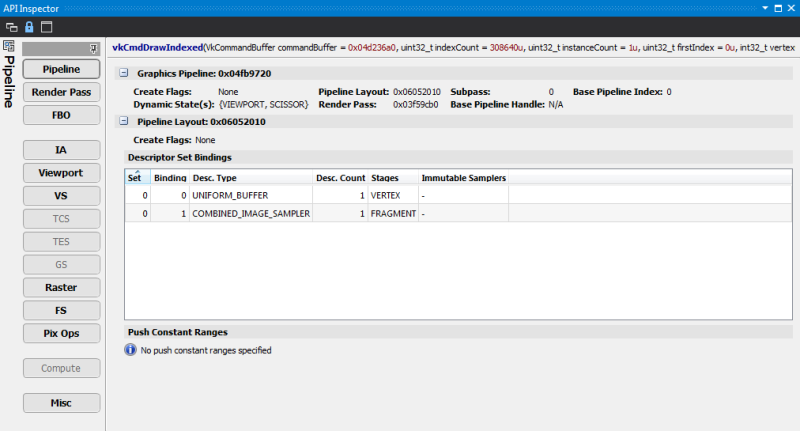
Render Pass
The Render Pass page shows information about the current render pass including: clear values, attachments operations, and sub-pass dependencies.
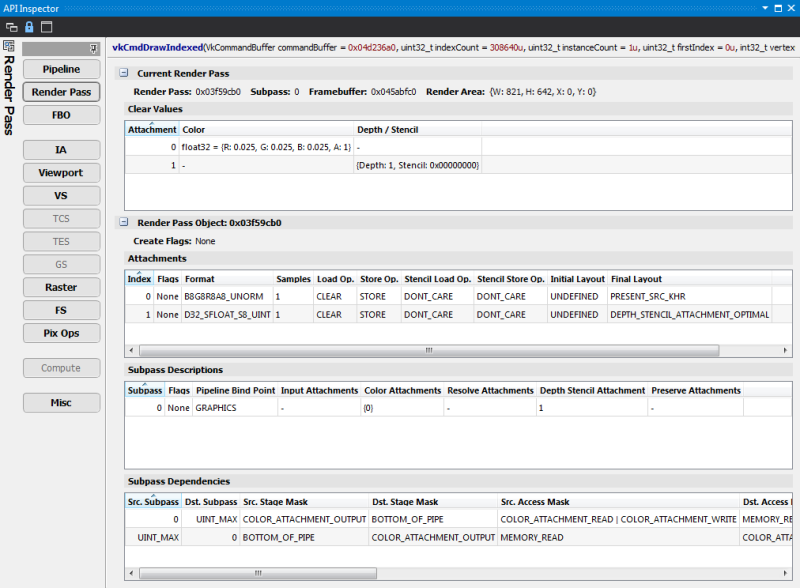
Frame Buffer Object (FBO)
The Frame Buffer Object page shows information about the current frame buffer object including: the creation flags, image view attachments, and the current state of the associated textures.
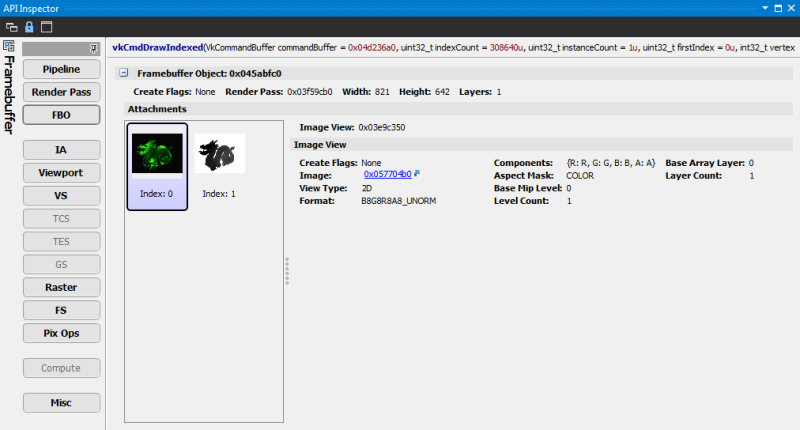
Input Assembler (IA)
The Input Assembler page shows the layout of your vertex buffers and index buffers, as well as the vertex bindings and attribute information.
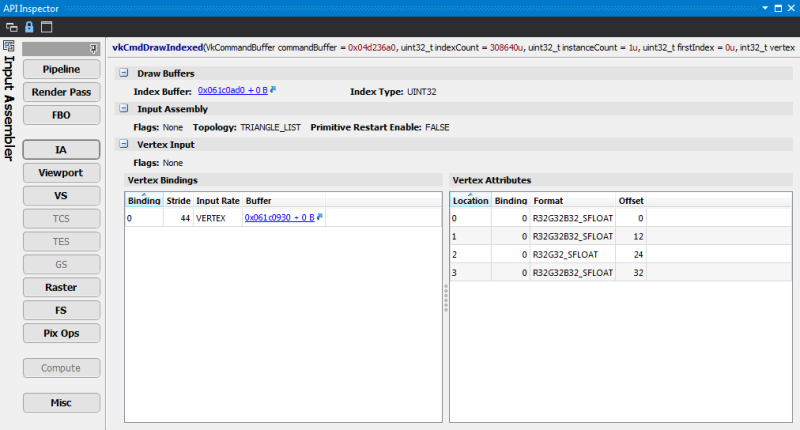
Shaders (VS, TCS, TES, GS, FS, CS)
The various shader pages display all of the shader modules, including: creation information, human readable SPIR-V source, current push constants, current bound descriptor sets, associated buffers, associated images and samples, and associated texel buffer views for this stage.
 | NOTE: A future release of NVIDIA Nsight will add reflection information to these views, to correlate shader information with resources. |
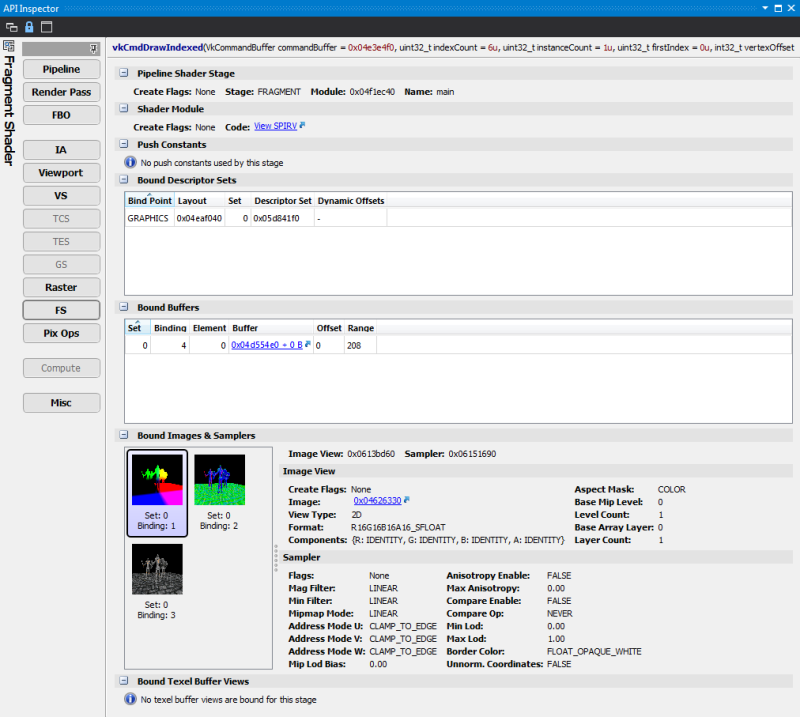
Raster
The Raster page shows all rasterization information associated with pipeline object include: polygons modes, cull modes, depth bias, and line widths.
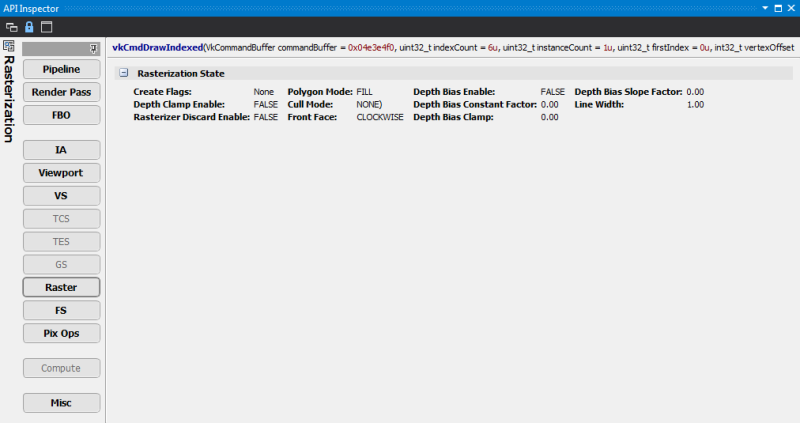
Pixel Operations (Pix Ops)
The Pixel Operations page displays information associated with the current pixel state including: depth/stencil state, multi-sample state, and blending state.

Miscellaneous Information (Misc)
The Miscellaneous Information page shows information related to the instance, physical device(s), logical device(s), and queue(s)

NVIDIA® Nsight™ Application Development Environment for Heterogeneous Platforms, Visual Studio Edition User Guide Rev. 5.2.161206 ©2009-2016. NVIDIA Corporation. All Rights Reserved.
Open topic with navigation
 Along the left side of the window, you can see the Pipeline State Navigator.
Along the left side of the window, you can see the Pipeline State Navigator.








